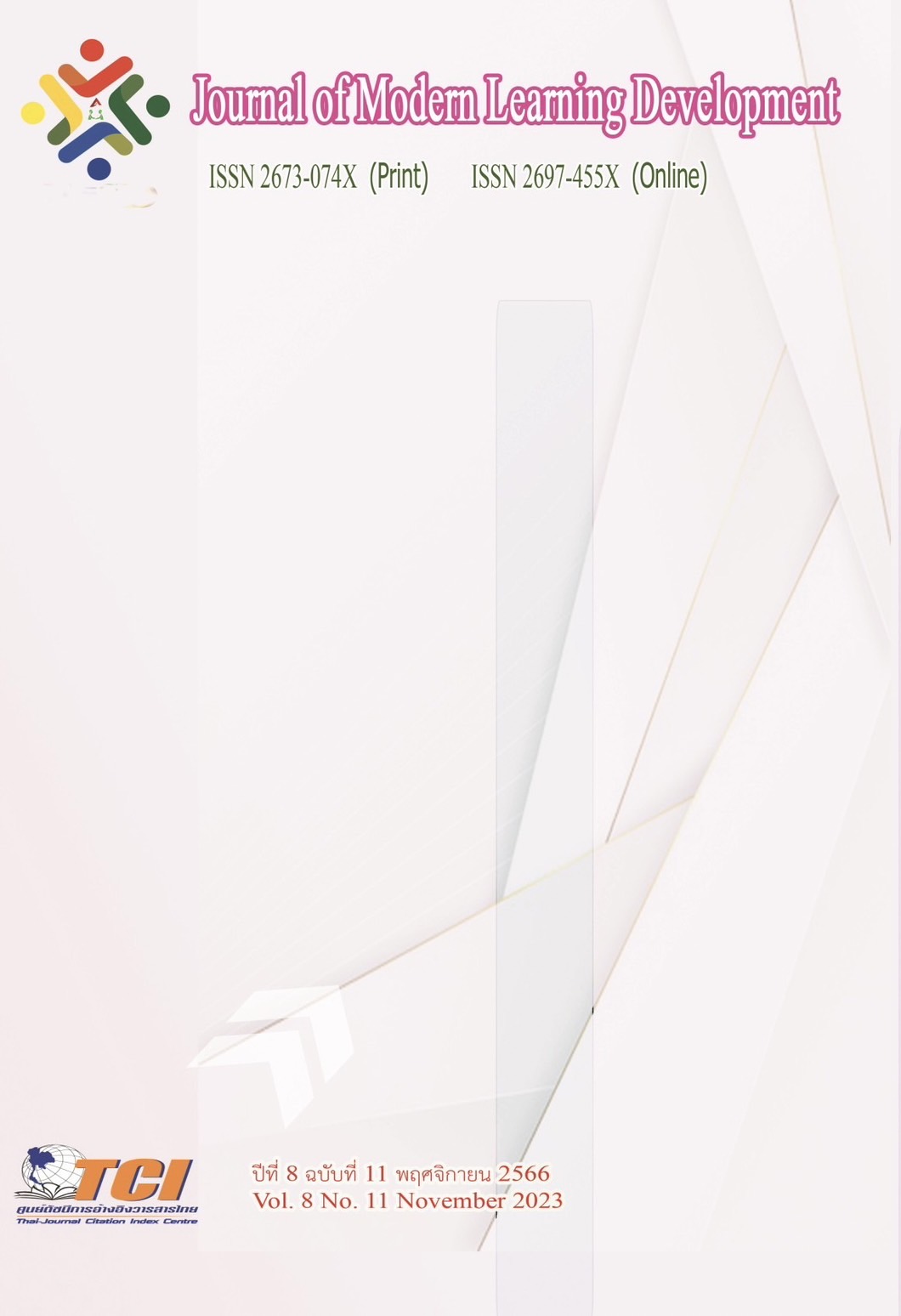Management Approach for Hybrid Working Efficiency
Main Article Content
Abstract
This research aims to study 1) the meaning of hybrid working in the Thai context, 2) the management approach for hybrid working efficiency, and 3) the problems and obstacles of hybrid working. It is qualitative research using phenomenological methods and in-depth interviews with key informants who are customer and supplier liaison employees and the human resources department. There were 20 keys informant interviewed and saturated data. Triangulation is a reliability data check. The researcher is a research tool along with taking notes, Tape recording, and data analysis using content analysis from the recorded interviews. The results found that 1) Hybrid working in Thai context refers to working in the office and working from home or anywhere with information technology. Flexible time and work location choice create a balance between personal life and work. Helps increase efficiency and employee commitment to the organization and make operations more efficient 2) Management approach for efficiency hybrid work explained by systems theory 2.1) Input factors, include adequate and ready-to-use information technology, and selecting appropriate people to work in the organization 2.2) Process, including human resource practices, personnel development using a remote system and personnel work tracking 2.3) Results, include work quantity, work quality, and quality of working life. 3) Problems and obstacles include noise and interference, space limitations, restrictions on electronic signatures, the challenge of adapting and the challenges of remote authentication.
Article Details
References
ชนกนันท์ โตชูวงศ. (2562). การเปลี่ยนแปลงการจัดการที่ส่งผลต่อประสิทธิภาพการทำงานที่บ้าน (Work from home) ของพนักงานบริษัทเอกชนในสภาวะวิกฤตการเกิดโรคระบาดไวรัสโควิด-19 ในเขตกรุงเทพมหานคร. ออนไลน์. สืบค้นเมื่อ 24 กันยายน 2564. แหล่งที่มา: http://www.vl-bstract. ru.ac.th/index.php/abstractData/viewIndex/150
ธงชัย ชลศิริพงษ์. (2564). การทำงานแบบไฮบริด คืออะไร ทำไมจะกลายเป็นมาตรฐานใหม่ของการทำงาน. ออนไลน์. สืบค้นเมื่อ 12 กันยายน 2564. แหล่งที่มา: https://brandinside.asia/hybrid-work-is-a-norm/
ธนาคารไทยพาณิชย์. (2564). ทำไมการทำงานแบบ Hybrid คือคำตอบในยุค Next Normal. ออนไลน์. สืบค้นเมื่อ 25 มีนาคม 2564. แหล่งที่มา: ttps://www.scb.co.th/th/personal-anking/stories/ salary-man/hybrid- working.html
ธนิยา รุจนเวชช์. (2565). การศึกษาประสิทธิภาพของการปฏิบัติงานที่บ้าน (Work From Home) จากการแพร่ระบาดเชื้อไวรัส COVID-19 ของพนักงานบริษัทเอกชนผลิตเครื่องดื่มที่ผสมแอลกอฮอล์. สารนิพนธ์การจัดการมหาบัณฑิต วิทยาลัยการจัดการ. มหาวิทยาลัยมหิดล.
บังอร เบ็ญจาธิกุล, (2564). ไฮบริด (Hybrid) การทำงานแบบผสมผสาน: มาตรฐานใหม่สำหรับการทำงานในอนาคต. วารสาร มจร พุทธปัญญาปริทรรศน์. 6 (3), 47-61.
ปรานต์ สุวรรณทัต. (2564). Google ประกาศแนวทางการทำงานแบบ “ไฮบริด” เข้าออฟฟิศ 3 วัน เลือก ทำงานจากที่ไหนก็ได้. ออนไลน์. สืบค้นเมื่อ 6 พฤษภาคม. แหล่งที่มา: https://brandinside. asia/google- hybrid-work/
วิภาวรรณ เส็งสาย. (2561). ความสัมพันธ์เชิงสาเหตุของปัจจัยบางประการที่ส่งผลต่อประสิทธิภาพการทํางานของพนักงานในบริษัทผู้ผลิตเครื่องดื่มแห่งหนึ่งในพื้นที่จังหวัดนครปฐม. วิทยานิพนธ์บริหารธุรกิจบัณฑิต. บัณฑิตวิทยาลัย: มหาวิทยาลัยศิลปากร.
Daft, Richard L. (2008). New Era of Management. 2nd ed. Ohio: Thomson South-Western.
Felstead, A., Jewson, N., Phizacklea, A., & Walters, S. (2002). Opportunities to work at home in the context of work‐life balance. Human resource management journal. 12 (1), 54-76.
Garrote Sanchez, D., Gomez Parra, N., Ozden, C., Rijkers, B., Viollaz, M., & Winkler, H. (2021). Who on earth can work from home?. The World Bank Research Observer, 36 (1), 67-100.
Iqbal, K. M. J., Khalid, F., & Barykin, S. Y. (2021). Hybrid workplace: The future of work. In Handbook of Research on Future Opportunities for Technology Management Education (pp.28-48). IGI Global.
Jamaludin, S., Azmir, N. A., Ayob, A. F. M., & Zainal, N. (2020). COVID-19 exit strategy: Transitioning towards a new normal. Annals of Medicine and Surgery, 59, 165-170.
Kitagawa, R., Kuroda, S., Okudaira, H., & Owan, H. (2021). Working from home and productivity under the COVID-19 pandemic: Using survey data of four manufacturing firms. Plos one, 16 (12), e0261761.
Radonić, M., Vukmirović, V., & Milosavljević, M. (2021). The impact of hybrid workplace models on intangible assets: The case of an emerging country. Amfiteatru economic, 23(58), 770-786.
Saatçi, B., Rädle, R., Rintel, S., O’Hara, K., & Nylandsted Klokmose, C. (2019). Hybrid meetings in the modern workplace: stories of success and failure. In Collaboration Technologies and Social Computing: 25th International Conference, CRIWG+ CollabTech 2019, Kyoto, Japan, September 4–6, 2019, Proceedings 25 (pp. 45-61). Springer International Publishing.
Shrestha, N., Shad, M. Y., Ulvi, O., Khan, M. H., Karamehic-Muratovic, A., Nguyen, U. S. D., & Haque, U. (2020). The impact of COVID-19 on globalization. One Health, 11, 100180.
Xiao, Y., Becerik-Gerber, B., Lucas, G., & Roll, S. C. (2021). Impacts of working from home
during COVID-19 pandemic on physical and mental well-being of office workstation users. Journal of Occupational and Environmental Medicine, 63 (3), 181-190.


